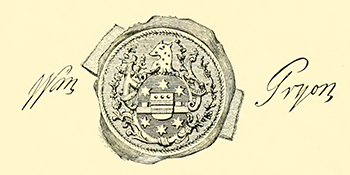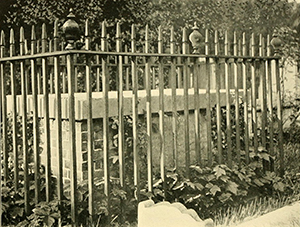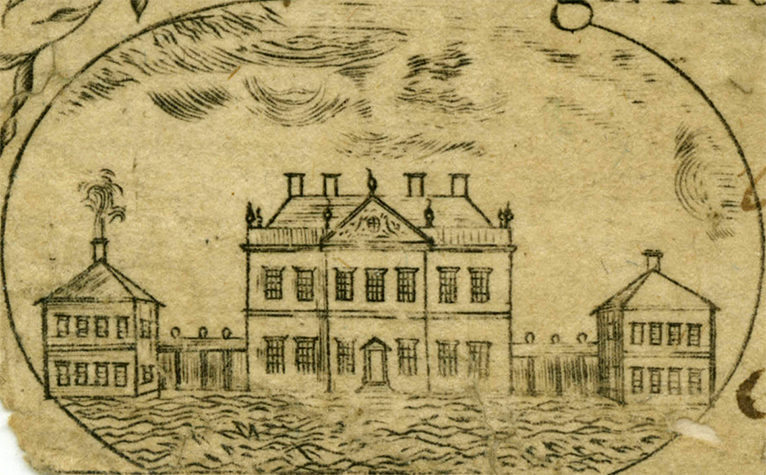Tryon, William
1729–27 Jan. 1788
See also: William Tryon, Research Branch, NC Office of Archives and History
 William Tryon, professional soldier and governor of the province of North Carolina and New York on the eve of the Revolution, was born at Norbury Park in Surrey, England. His father was Charles Tryon, of Bulwick, Northamptonshire, who descended from a family that had fled Spanish persecution in the Lowlands and established itself in England in trade and shipping. His mother was Lady Mary Shirley, the daughter of Robert Shirley, first Earl Ferrers. Through her relatives the Tryons appear to have enjoyed some connections at court.
William Tryon, professional soldier and governor of the province of North Carolina and New York on the eve of the Revolution, was born at Norbury Park in Surrey, England. His father was Charles Tryon, of Bulwick, Northamptonshire, who descended from a family that had fled Spanish persecution in the Lowlands and established itself in England in trade and shipping. His mother was Lady Mary Shirley, the daughter of Robert Shirley, first Earl Ferrers. Through her relatives the Tryons appear to have enjoyed some connections at court.
Young Tryon began his career in the army. In 1751 he was commissioned a lieutenant in the First Regiment of Foot Guards. Marriage with Margaret Wake of London's fashionable West End in 1757 brought him her fortune of £30,000 and additional connections with the ruling caste of Great Britain. His wife was related to Wills Hill, second Viscount Hillsborough, who became First Lord of Trade and Plantations in 1763 and Secretary of State for the Colonies when that office was created in 1768. By 1758 Tryon had risen to lieutenant colonel in his regiment, but soon a new opportunity appeared that Hillsborough may well have opened for him. Aged Governor Arthur Dobbs of North Carolina asked for retirement in 1764, and Tryon was promptly named lieutenant governor, with instructions to proceed to North Carolina and relieve the old man so he could return for his health to the British Isles. Tryon sold Norbury Park, resigned his commission, and sailed in the snow Friendship with his wife and small daughter Margaret, arriving at Cape Fear on 10 Oct. 1764. Tryon now cooled his heels while Dobbs delayed his departure.
On the death of Dobbs at Cape Fear on 28 Mar. 1765, Tryon took over his duties and was commissioned governor a few months later. His first problem was to deal with the turmoil that followed passage of the Stamp Act. Demonstrations were held during the summer and fall in the principal ports. A crowd at Wilmington, only a few miles from Tryon's residence at Brunswick, caught the Crown-appointed stamp tax collector at his lodgings and forced him to resign the office. When the packets of stamped paper arrived in November, the captain of H.M. sloop Diligence refused to land them because of threatened violence ashore.
Tryon did not favor the tax because he believed it would drain the province of specie. He went so far as to offer to pay the tax for taverns in the larger communities and for the legal documents on which he was entitled to collect fees. He demanded compliance with the law, but there was little he could do, lacking vessels to patrol the sound ports. Early in 1766, after he had seized three vessels that arrived at Cape Fear without stamped papers, his home was surrounded by four to five hundred armed men. Despite Tryon's determination, Cornelius Harnett and other leaders were able to free the vessels and keep the deeper water ports of Brunswick and Wilmington also open.
In June 1766 Tryon formally announced repeal of the Stamp Act and an end to the conflict. From the struggle he and the eastern North Carolinians emerged with mutual respect. What he hoped to do now was move along with matters he considered of first priority for the province—one being the location of the capital, not at the south-eastern tip of North Carolina, but in the most central coastal town, New Bern. There he proposed to build a governor's house at which he would reside and the Council would meet. For this purpose he had brought with him on the Friendship "a very worthy . . . master builder," John Hawks.
Since the early part of the century, the capital had been moved about from one town to another. Tryon felt that "the late great indulgences granted to the colonies"—meaning repeal of the Stamp Act—would help induce the North Carolinians to pay for an expensive building. On 7 Dec. 1766 the Assembly passed by a large majority an appropriation of £5,000 with which to purchase lots in New Bern and begin construction. A month later Tryon and "John Hawks of Newbern Architect" signed a contract, and at the time Hawks estimated the total cost of the edifice and dependencies at £15,000. On 15 Jan. 1768 the additional money was voted. By mid-1770 the building was sufficiently completed for the Tryons to move in. The first Assembly session to use the structure convened in New Bern on 5 Dec. 1770.
"Tryon's Palace," as it became known, was to be paid for almost entirely by a poll tax, which bore far harder on the small farmer, particularly in the western counties, than on the merchants and plantation owners of the eastern counties. Western North Carolina had long seethed with grievances—dishonest officials, uncertain land titles, nonconformist resentment, and lack of equal representation in the lower house, to name a few. The heavy poll tax for a "palace" inflamed all these grievances, and the back-country dissidents, who called themselves Regulators, began to grow in numbers and boldness. In 1768 Tryon led a small militia force to put down a riot at Hillsborough, but the violence persisted.
In the spring of 1771 Tryon and the eastern leaders determined to muster a large force, equipped with cannon, for a full-scale expedition against the Regulators. The result was that Tryon's column, numbering about 1,100 militia, put to flight some 2,000 Regulators on 16 May 1771. The clash took place on the Alamance River near the present city of Burlington. Of the Regulators, 20 were killed and possibly 100 were wounded. The militia lost 9 killed and 61 wounded. Tryon hanged one Regulator leader, James Few, but most of the others escaped to northern provinces. The governor offered pardons to the rank and file, and 6,000 came forward to take the oath.
Tryon's tour of duty in North Carolina should not be judged solely in the light of Alamance. He proved an able administrator, and his dispatches reflect vividly what he saw as the need for the province's economic development. He sought establishment of a postal system to the north. He supported measures to link the backcountry with the Cape Fear River's head of navigation. He achieved the unprecedented running of boundaries with western South Carolina and the Cherokee nation. He urged the establishment of Queen's College in Charlotte, and he signed a law (later disallowed) to permit performance of the marriage rite by Presbyterian ministers.
While on the Alamance expedition, Tryon learned that his wish to become governor of New York had been approved, as John Murray, Earl of Dunmore, was leaving the position to become governor of Virginia. Tryon sailed from New Bern in the sloop Sukey and arrived in New York port on 8 July 1771.
Here, too, he won respect as an administrator. In his first message to the Assembly, he urged strengthening of the militia and support for New York Hospital. He gave a large tract of land to establish King's College, which became Columbia University. He attempted to pacify the violent dispute that had broken out between New York and New Hampshire over conflicting grants in the territory known as Vermont. Unhappily, on 29 Dec. 1773, in a disastrous fire at Fort George, his residence, he lost all his personal effects, including an extensive library. For the loss, the Crown granted him £5,000 compensation.
For consultation on the New York–New Hampshire dispute and other problems, his superiors summoned him to London, and he sailed in April 1774 in the packet Mercury for a stay of nearly a year in England. When he returned to New York on 25 June 1775, he found all the colonies in arms and General George Washington appointed commander-in-chief of a growing Continental army. Washington and Tryon arrived in New York on the same day (though not at the same hour), each receiving a warm welcome from his supporters in that city of divided loyalties.
Washington immediately warned Major General Philip Schuyler that Tryon should be carefully watched because of his many adherents among New York Loyalists. He would not hesitate to order Tryon's seizure, said Washington, if he felt it necessary, but the arrest of a Crown official being "quite a new Thing and of exceeding great Importance," he preferred to have guidance from the Continental Congress. John Adams's diary reports a desultory debate on the matter beginning on 5 October, but Congress ended up taking no action.
Possibly having learned of the debate, Tryon went aboard the sloop Halifax in New York harbor on 19 October. Later he moved to the ship Dutchess of Gordon, where he remained until the Howe brothers captured the city in September 1776. No question now remained of continuing the civil administration, and in April of the following year he assumed command of a corps of Loyalists. His health was not good, and he had already asked permission to return to England if he could not have a military command of army regulars.
 On 5 June 1778 Tryon was named colonel of the Seventieth (or Surrey) Regiment with the additional rank of major general "in America." His military exploits consisted chiefly in launching raids against Washington's supply bases in Connecticut. His troops savagely burned the town of Fairfield, and he wrote an indiscreet letter avowing his wish to put the torch to every safety committeeman's house in the area. The Reverend John Vardill, a British agent, wrote William Eden, chief of British espionage, that the statement "has made him very odious & ridiculous."
On 5 June 1778 Tryon was named colonel of the Seventieth (or Surrey) Regiment with the additional rank of major general "in America." His military exploits consisted chiefly in launching raids against Washington's supply bases in Connecticut. His troops savagely burned the town of Fairfield, and he wrote an indiscreet letter avowing his wish to put the torch to every safety committeeman's house in the area. The Reverend John Vardill, a British agent, wrote William Eden, chief of British espionage, that the statement "has made him very odious & ridiculous."
Tryon's governorship, no more than nominal since the outbreak of war, officially came to an end in 1780 with the appointment of James Robertson as the last of New York's colonial governors. Early that year a "very severe gout" impelled Tryon to return to England. He had made a dubious purchase of several thousand acres from the Mohawk Indians, all of which were expropriated by the state of New York. He had hoped for royal rewards, but for his services was merely made colonel of the Twenty-ninth Foot and promoted to lieutenant general on the retired list.
Tryon was a study in flawed ability and capacity for leadership. Vardill called him "a Gentleman of Integrity & Fortitude . . . made by his Vanity a Dupe to every flattering Impostor . . . too much guided by personal Resentment to be trusted." He died at his home on Upper Grosvenor Street and was buried in the churchyard at Twickenham, Surrey. No authenticated portrait of him has been found. A facsimile of his coat of arms is printed in Haywood's Governor William Tryon and His Administration of the Province of North Carolina. His only son died in infancy in North Carolina, and his daughter never married, so there are no descendants.
References:
D. B. Barger, "Governor Tryon's House in Fort George," New York History 35 (1954).
A. T. Dill, Governor Tryon and His Palace (1955).
Gentleman's Magazine, December 1757, February 1788.
Marshall De Lancey Haywood, Governor William Tryon and His Administration in the Province of North Carolina (1903).
Solomon Henner, The Career of William Tryon as Governor of the Province of New York, 1771–1780 (1968).
Paul D. Nelson, William Tryon and the Course of Empire (1990).
E. B. O'Callaghan, ed., Documents Relative to the Colonial History of the State of New-York, vol. 8 (1857).
William S. Powell, ed., The Correspondence of William Tryon and Other Selected Papers, 2 vols. (1980–81).
William S. Powell and others, eds., The Regulators in North Carolina: A Documentary History, 1759–1776 (1971).
William L. Saunders, ed., Colonial Records of North Carolina, vols. 7–8 (1890).
Additional Resources:
Tryon, William, 1729-1788. Correspondence of William Tryon and other selected papers: Volume 1. Raleigh [N.C.]: Division of Archives and History, Dept. of Cultural Resources. 1980. https://digital.ncdcr.gov/Documents/Detail/correspondence-of-william-tryon-and-other-selected-papers-volume-1/2148950 (accessed February 19, 2013).
Tryon, William, 1729-1788. Correspondence of William Tryon and other selected papers: Volume 2. Raleigh [N.C.]: Division of Archives and History, Dept. of Cultural Resources. 1981. https://digital.ncdcr.gov/Documents/Detail/correspondence-of-william-tryon-and-other-selected-papers-volume-2/2148955?item=2232887 (accessed February 19, 2013).
"Portrait Of A British Officer, Accession #: P.TP.1950.001.029." c. 1749-1769. North Carolina Tryon Palace.
Tryon Palace website: http://www.tryonpalace.org/
"Orange County inhabitants petition Governor Tryon." Revolutionary North Carolina. LearnNC.org. http://www.learnnc.org/lp/editions/nchist-revolution/4251 (accessed February 19, 2013).
"CSR Documents by Tryon, William, 1729-1788." Colonial and State Records of North Carolina. Documenting the American South, University of North Carolina at Chapel Hill. https://docsouth.unc.edu/csr/index.html/creators/csr10075 (accessed February 19, 2013).
Image Credits:
Tisdale, William, engraver. "Five-dollar bill of credit, 1775. (call no. CK123.1)" Hillsborough, N.C.: North Carolina Provincial Congress. 1775. North Carolina Collection Numismatic Collection, University of North Carolina at Chapel Hill. http://dc.lib.unc.edu/cdm/compoundobject/collection/numismatics/id/221/show/220/rec/18 (accessed February 19, 2013).
Bobbett, Albert, engraver. "Governor Tryon and the Regulators." The Picture Collection of the New York Public Library. http://digitalgallery.nypl.org/nypldigital/dgkeysearchdetail.cfm?trg=1&strucID=701246&imageID=808449 (accessed February 19, 2013).
"Signature and Armorial Seal of Governor Tryon." Governor William Tryon, and his administration in the province of North Carolina, 1765-1771: services in a civil capacity and military career as commander-in-chief of colonial forces which suppressed the insurrection of the regulators. Raleigh: E. M. Uzzell, Printer. 1903. https://archive.org/stream/govwilliamtryon00hayw#page/12/mode/2up (accessed February 19, 2013).
"The tomb of Governor Tryon,Twickenham, England." Governor William Tryon, and his administration in the province of North Carolina, 1765-1771: services in a civil capacity and military career as commander-in-chief of colonial forces which suppressed the insurrection of the regulators. Raleigh: E. M. Uzzell, Printer. 1903. https://archive.org/stream/govwilliamtryon00hayw#page/200/mode/2up (accessed February 19, 2013).
1 January 1996 | Dill, Alonzo T.
